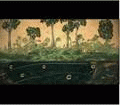Until recently, tropical peat swamp forests in Indonesia have been subject to increasing pressure from land-use change and excessive drainage. This has increased greenhouse gas (GHG) emissions and risk of fires. Five tropical peat landscapes under different management regimes were selected and assessed with regards to GHG emissions and vulnerability to fire. Converted peat swamp forest emitted CO 2 at a similar rate to primary and secondary peat swamp forests. Total emissions ranged between 41 and 52 Mg CO 2 /ha/yr, and 85% of this was from heterotrophic respiration. Managing groundwater levels (GWL) is crucial to GHG mitigation actions. Peatland fire risk is closely associated with GWL, and fire risk can be reduced by 30% when peat rewetting is prioritized in the most vulnerable areas. Lack of coordinated water management could lead to uncontrollable GWLs, peat subsidence, and fires, causing large GHG emissions and other environmental degradation. Government-initiated Forest Management Units could manage peatlands at a regional level. Compliance mechanisms need to be institutionalized to control emissions, land subsidence, and fire incidence.
DOI:
https://doi.org/10.1002/9781119639305.ch19
Altmetric score:
Dimensions Citation Count:
























